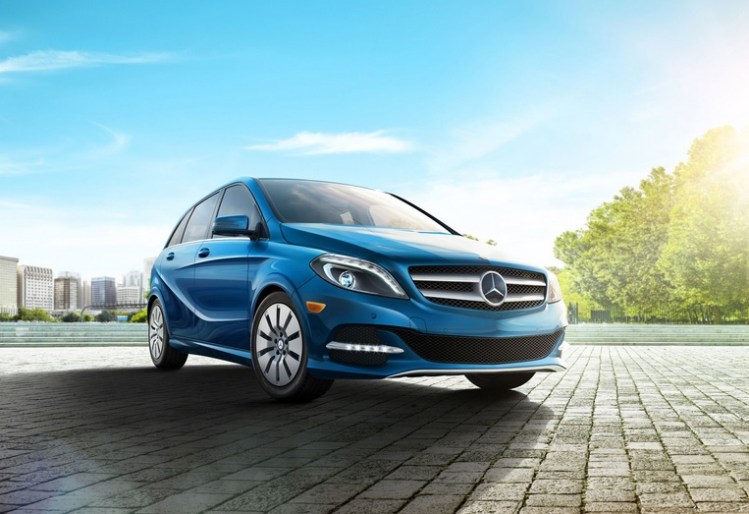When Mercedes-Benz contacted me last month to ask if I’d be interested in driving its new B-class electric, I thought they were either too sure of themselves or foolish. Why else would they ask a self-proclaimed Tesla fanboy to reconsider his “breakup” with them?
In February 2013, I wrote that after driving my Model S, I couldn’t drive my Mercedes–Benz anymore — it was like listening to an old cassette tape. I compared my Tesla to a supermodel working a Paris catwalk and the Porches and Ferraris owned by my friends to supercharged lawn mowers.
But this email from Mercedes-Benz was from a stodgy old German car company, not from a brash kid in Silicon Valley. So I decided to take them up on their offer.
My first reaction upon driving the car was that these people surely were smoking something if they thought I would trade in my Tesla for this four-door hatchback. It just didn’t have the acceleration or torque. It felt slow and small. But then I realized that wasn’t a fair comparison. The two cars are from different categories and price brackets. It wasn’t an either/or: The Mercedes is for a different market. The Mercedes public relations team had just been very creative in getting my attention.
The B-class electric is indeed a great small car. It is as quiet as a Tesla Model S; it drives with comfort and elegance. And it is relatively economical. The base price of the Mercedes is $41,450; the Tesla costs $69,900. (But all electric cars qualify for $10,000 tax rebates on those prices in the state of California.) Of course, you get a lot more in a Tesla, including a battery with twice the range, an Internet-connected dashboard, and an eight-year “infinite miles” warranty. But a Mercedes has its own old-world elegance.
The Mercedes is certainly better than the three other electric cars I have driven: the Nissan Leaf, the Toyota Prius, and the Chevrolet Volt. It’s also about $10,000 more expensive. But it’s much better than any Mercedes I have driven. It accelerates without hesitation, doesn’t have the deafening engine noise, and gives you excellent control of the car with its regenerative braking system. It surely helps that Tesla makes the Mercedes B-class motor, as well as its battery technology.
What most surprised me was that Mercedes underestimates the range of its battery. Its rated range is 85 miles. In the Tesla, I usually allow for 20 percent more consumption than the rated range, because I drive the car … like a Tesla (you can’t resist rapidly accelerating the car to the speed limit — it’s like getting a spaceship up to warp speed). In the Mercedes, I made a trip of 67 miles with 80 miles on the power gauge and had 30 miles to spare. I drove in electron-conserving “E” mode because I was worried about running out of power, but I never get this type of efficiency when I drive in the similar “range mode” in the Tesla.
The real competitor to the B-class is likely to be the BMW i3 — and a slew of other luxury cars to be released over the next couple of years. Every car maker is surely preparing for the inevitable future when electric engines replace the primitive internal-combustion engines that have too long driven our automobiles. Bart Herring, Mercedes–Benz U.S.A. general manager of product management, believes there will be a transition period over a decade and there will be many choices of engines. But as he explained, you can expect that more and more “normal” cars in 2025-2030 will be battery-driven or hydrogen-fueled.
My bet is on electric batteries. Earlier this year, Tesla announced that it is building a “Gigafactory” — a gigantic $5 billion plant to produce 35GWh of battery storage a year (more than in all the lithium-ion batteries produced worldwide in 2013). Tesla set expectations that prices will drop by 30 percent when it starts ramping up production in 2017. The capability and range of batteries will undoubtedly increase significantly, and I expect that they will double their driving range and halve their cost by about 2020.
Even if fuel cell–based technologies win the race, electric motors will still rule the day. These technologies generate electricity as needed and allow for much faster charging than the Tesla type of vehicle does. Either way, we are going to see dramatic changes in the economics of the automobile industry. Electric cars will be cheaper, faster, and better in almost every way than internal-combustion alternatives. We will all be upgrading to clean technologies and enjoying driving our “spaceships that travel on land.”
Let me correct myself. I expect that our cars will be driving themselves … but that is a different story.
Vivek Wadhwa is a fellow at the Rock Center for Corporate Governance at Stanford University, director of research at the Center for Entrepreneurship and Research Commercialization at Duke’s engineering school and distinguished scholar at Singularity and Emory universities. His past appointments include Harvard Law School and University of California Berkeley. You can follow him on Twitter @wadhwa.
VentureBeat's mission is to be a digital town square for technical decision-makers to gain knowledge about transformative enterprise technology and transact. Learn More

